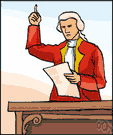I begin with Mark Forsyth's entertaining video clip discussing the etymology of a few political terms and conclude with George Orwell's more serious essay on politics and communication.
A number of Vocabulogic posts have explored how words tend to change in form, meaning, and usage over time, referencing the study of etymology. For example, in one post I describe how the Common Core State Standards include the study of etymology in high school English classes. See Etymology and Morphology Standards. In another post, Shane Templeton discusses how word meanings change over time and are "more than the sum of their parts".
Along the same lines, I offer an interesting video, courtesy of TED Talks. With plenty of humor and some embellishment, etymologist Mark Forsyth makes the point that words change meaning based on the usage at the time. Try as we might, we cannot control word meaning, nor cast it in cement. It is likely to take on a life of its own. Speechifiers take note!
Forsyth states:
Of more relevance, Forsyth explores how the term president came to reference the "chief executive officer for the US" and how its connotations have drastically changed since first applied to George Washington. The bit about the US Senate may be somewhat apocryphal, as some have suggested, but the story is entertaining and provides us with word-sleuthing material.
This short video might perhaps be interesting to secondary and tertiary students studying civics, US History, or etymology. The video runs 6.26 minutes, published June 2012. Watch it below, or view it directly at the site, TED.com.
A number of Vocabulogic posts have explored how words tend to change in form, meaning, and usage over time, referencing the study of etymology. For example, in one post I describe how the Common Core State Standards include the study of etymology in high school English classes. See Etymology and Morphology Standards. In another post, Shane Templeton discusses how word meanings change over time and are "more than the sum of their parts".
Along the same lines, I offer an interesting video, courtesy of TED Talks. With plenty of humor and some embellishment, etymologist Mark Forsyth makes the point that words change meaning based on the usage at the time. Try as we might, we cannot control word meaning, nor cast it in cement. It is likely to take on a life of its own. Speechifiers take note!
Forsyth states:
"Politicians try to pick words and use words to shape reality and control reality, but in fact, reality changes words far more than words can ever change reality.”Forsyth discusses two political terms, snollygoster and president. What's a snollygoster? By the sound of the word, and knowing it is used to describe politicians, I suppose we can all guess.
Of more relevance, Forsyth explores how the term president came to reference the "chief executive officer for the US" and how its connotations have drastically changed since first applied to George Washington. The bit about the US Senate may be somewhat apocryphal, as some have suggested, but the story is entertaining and provides us with word-sleuthing material.
This short video might perhaps be interesting to secondary and tertiary students studying civics, US History, or etymology. The video runs 6.26 minutes, published June 2012. Watch it below, or view it directly at the site, TED.com.
Politicians and Language:
How do the words we use reflect our personality? James (Jamie) W. Pennebaker, a psychologist at the University of Texas, analyzed the speech patterns used during the debate between President Obama and Governor Romney. His analysis includes the use of pronouns and function words as well as content words and positively or negatively charged phrases. He compares the two candidates to former Presidents Clinton, Bush, and Reagan. View his brief interview at Wordwatcher, a You Tube channel hosted by UT Austin. You might be surprised at his analysis.
ALSO, if the relationship between words, ideas, and communication interests you, see George Orwell's essay, Politics and the English Language, published in 1946. I found it online, courtesy of Vincent Ferraro, Professor of International Politics at Mount Holyoke.
Citing five excerpts from various publications, Orwell shows how words can muddle our thinking -- how easily we can confuse ourselves and our audience with unclear language -- and not necessarily intentionally. But politicians on both sides of the aisle have been known to muddy the waters, as Orwell shows. He offers sound advice for anyone who wants to improve both their thought processes and their communication, concluding with the following statement:
Political language -- and with variations this is true of all political parties, from Conservatives to Anarchists -- is designed to make lies sound truthful and murder respectable, and to give an appearance of solidity to pure wind. One cannot change this all in a moment, but one can at least change one's own habits, and from time to time one can even, if one jeers loudly enough, send some worn-out and useless phrase -- some jackboot, Achilles' heel, hotbed, melting pot, acid test, veritable inferno, or other lump of verbal refuse -- into the dustbin, where it belongs.






